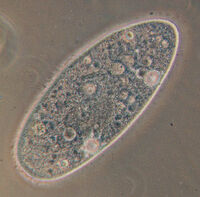| iProtists | ||||
|---|---|---|---|---|
 Paramecium aurelia, a ciliate
| ||||
| Scientific classification | ||||
| ||||
|
Protists /ˈproʊ.tɪst/ (GenAm) are a diverse group of organisms, comprising those eukaryotes that are not animals, plants, or fungi. They are usually treated as the kingdom Protista or Protoctista. The protists are a paraphyletic grade, rather than a natural (monophyletic) group, and do not have much in common besides a relatively simple organization (unicellular, or multicellular without highly specialized tissues). Essentially, the Kingdom Protoctista is made up of organisms which cannot be classified into any other kingdom.
Protists were traditionally subdivided into several groups based on similarities to the higher kingdoms: the animal-like protozoa, the plant-like algae, and the fungus-like slime molds and water molds. These groups often overlap, and have been replaced by phylogenetic classifications. However, they are still useful as informal groups for describing the morphology and ecology of protists.
At one time, bacteria were also considered protists, under the three-kingdom system of Animalia (corresponding closely to the modern kingdom), Plantae (which included Fungi as well as plants), and Protista (everything else). See kingdom (biology). However, most recent texts treat bacteria separately.
Protozoa, the Animal-like Protists
Protozoa are mostly single-celled, motile protists that feed by phagocytosis, though there are numerous exceptions. They are usually only 0.01-0.5 mm in size, generally too small to be seen without a microscope. Protozoa are ubiquitous throughout aqueous environments and the soil, commonly surviving dry periods as cysts or spores, and include several important parasites. Based on the method of locomotion, protozoa are grouped into:
| Flagellates | with long flagella | e.g., Euglena |
| Amoeboids | with transient pseudopodia | e.g., Amoeba |
| Ciliates | with multiple, short cilia | e.g., Paramecium |
| Sporozoa | non-motile parasites; some can form spores | e.g., Toxoplasma |
Algae, the Plant-like Protists
They include many single-celled organisms that are also considered protozoa, such as Euglena, which many believe have acquired chloroplasts through secondary endosymbiosis. Others are non-motile, and some (called seaweeds) are truly multicellular, including members of the following groups:
| Chlorophytes | green algae, are related to higher plants | e.g., Ulva |
| Rhodophytes | red algae | e.g., Porphyra |
| Heterokontophytes | brown algae, diatoms, etc. | e.g., Macrocystis |
The green and red algae, along with a small group called the glaucophytes, appear to be close relatives of other plants, and so some authors treat them as Plantae despite their simple organization. Most other types of algae, however, developed separately. They include the haptophytes, cryptomonads, dinoflagellates, euglenids, and chlorarachniophytes, all of which have also been considered protozoans.
Note some protozoa host endosymbiotic algae, as in Paramecium bursaria or radiolarians, that provide them with energy but are not integrated into the cell.
Fungus-like protists
Various organisms with a protist-level organization were originally treated as fungi, because they produce sporangia. These include chytrids, slime moulds, water moulds, and Labyrinthulomycetes. Of these, the chytrids are now known to be related to other fungi and are usually classified with them. The others are now placed among the heterokonts (which have cellulose rather than chitin walls) and the Amoebozoa (which do not have cell walls).
Phylogenetic classifications
The taxonomy of protists is still changing. Newer classifications[1] attempt to present monophyletic groups based on ultrastructure, biochemistry, and genetics. Because the protists as a whole are paraphyletic, such systems often split up or abandon the kingdom, instead treating the protist groups as separate lines of eukaryotes. The recent scheme by Adl et al. (2005)[2] is an example which does not bother with ranks (phylum, class, etc.).
Some of the main groups of protists, which may be treated as phyla, are listed in the taxobox at right. Most have been established as monophyletic, though for some this is still uncertain; for instance the metamonads, which may be paraphyletic to other excavates, and the Chromista, which may be paraphyletic to the alveolates (see chromalveolates). Various smaller groups of protists also existed; these are listed under the traditional categories, linked to above.
For more discussion of relationships between different protists and their evolution, see eukaryote or the articles referenced below.